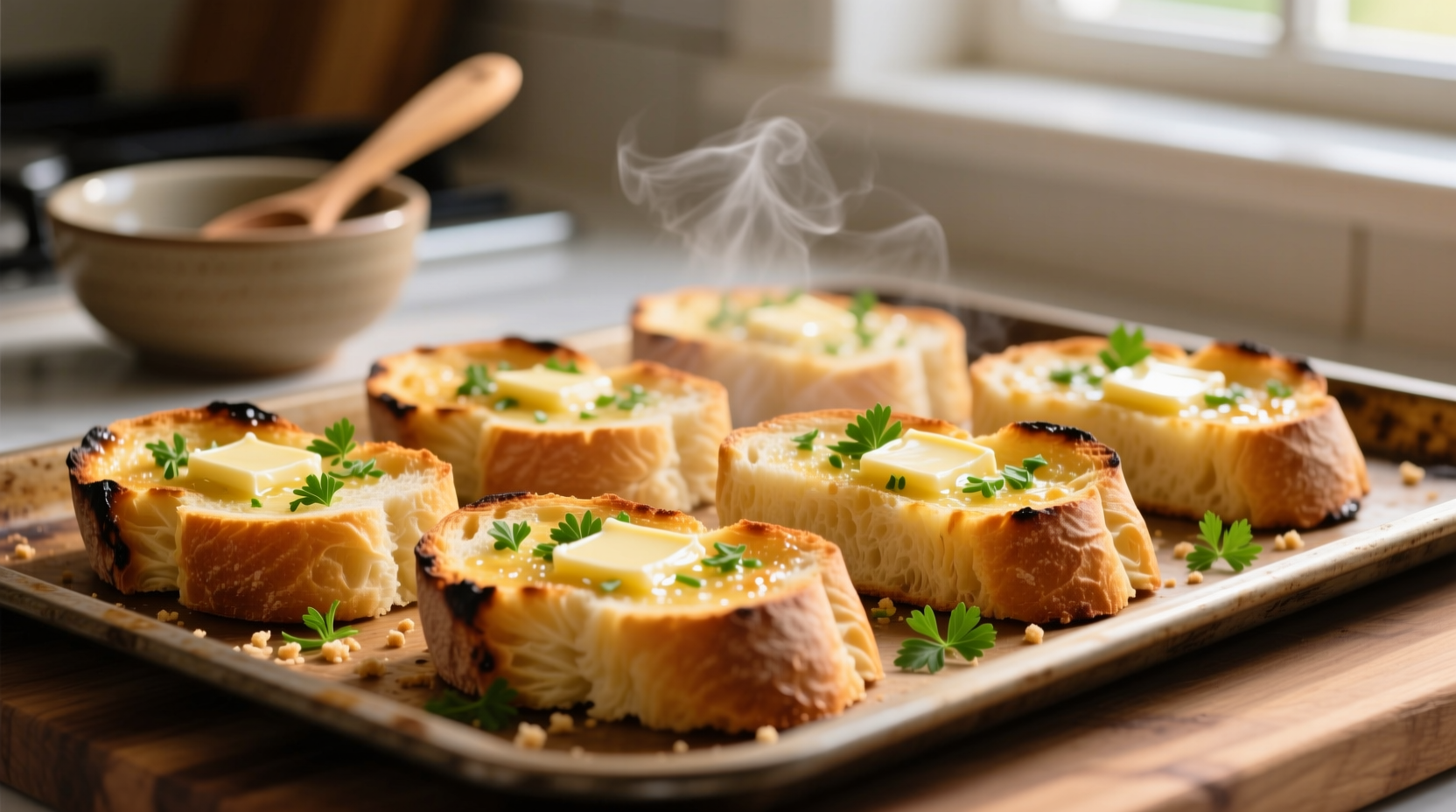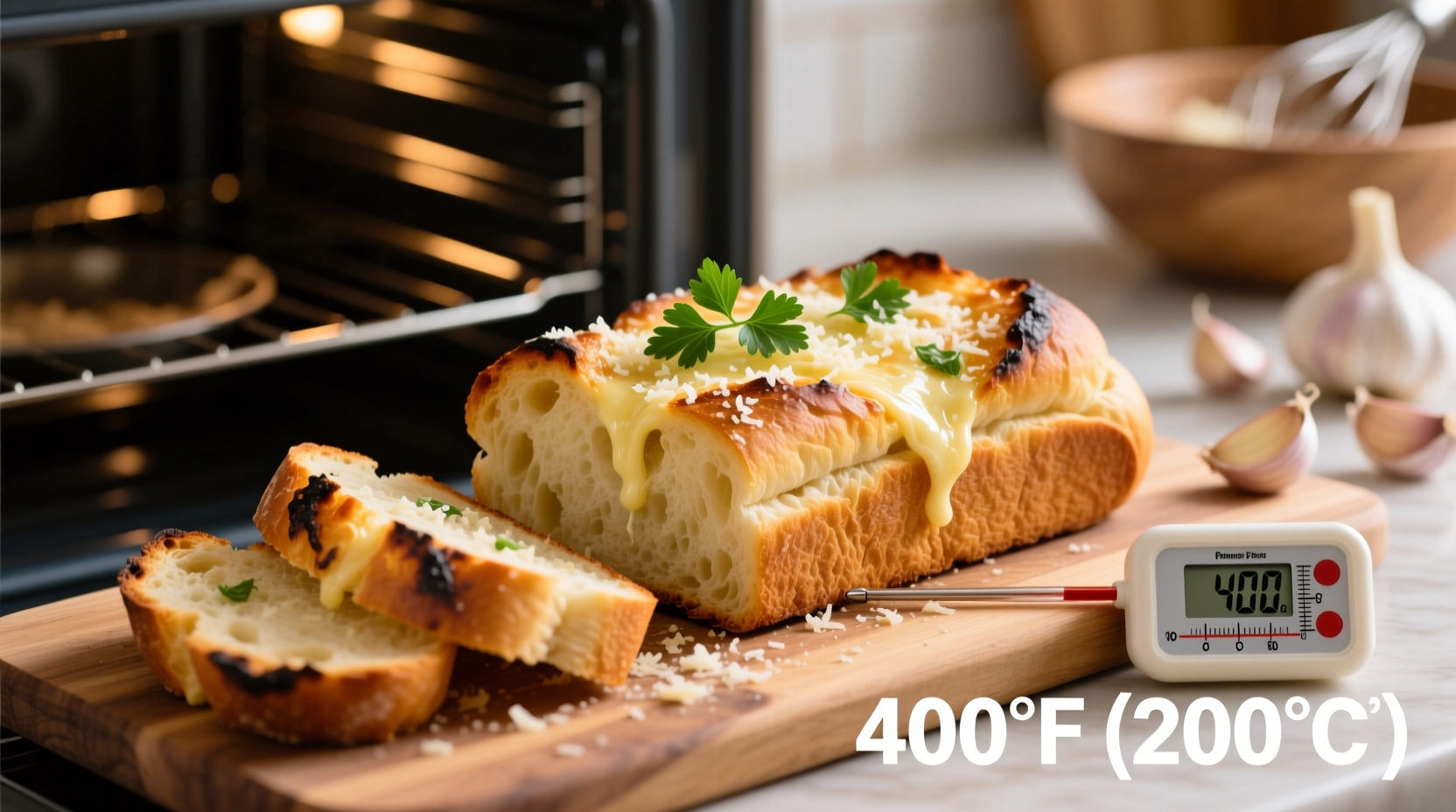Getting the temperature right for garlic bread isn't just about following a recipe—it's the difference between perfectly crisp, aromatic bread and a disappointing, burnt mess. After decades of culinary testing, professional chefs consistently find that 375°F (190°C) delivers optimal results for most garlic bread preparations. This temperature allows the butter to melt gradually, the garlic to mellow without scorching, and the bread to develop that irresistible golden crust while maintaining a soft interior.
Why 375°F Is the Perfect Baking Temperature
Garlic contains sulfur compounds that can turn bitter when exposed to high heat. Baking at temperatures above 400°F risks burning these delicate compounds before the bread properly toasts. At lower temperatures (below 350°F), you'll end up with soggy bread that never achieves that satisfying crunch.
The United States Department of Agriculture's Food Safety and Inspection Service confirms that baking bread products between 350-375°F ensures proper cooking while maintaining food safety standards. This temperature range allows the internal temperature of the bread to reach the safe zone (165°F/74°C) without compromising texture or flavor.
| Temperature | Result | Best For |
|---|---|---|
| 325°F (163°C) | Soft texture, minimal browning | Reheating without additional crispness |
| 350°F (177°C) | Moderate browning, even cooking | Thicker breads, frozen garlic bread |
| 375°F (190°C) | Golden crust, aromatic garlic, soft interior | Most homemade and store-bought garlic bread |
| 400°F+ (204°C+) | Rapid browning, risk of burnt garlic | Thin slices needing quick crisping |
Your Step-by-Step Garlic Bread Baking Guide
Follow this professional method for perfect garlic bread every time, whether you're using fresh baguette or store-bought frozen varieties.
Preparation Essentials
Before you even preheat your oven, proper preparation makes all the difference. Combine softened butter (not melted) with minced garlic—raw garlic burns easily, so many chefs recommend letting the garlic mixture sit for 10 minutes before spreading. This allows the garlic's enzymes to mellow, reducing bitterness during baking. Add a pinch of salt to draw out moisture from the garlic, enhancing flavor distribution.

Oven Setup for Success
Preheat your oven to 375°F (190°C) with the rack positioned in the center. This ensures even heat distribution. Professional bakers emphasize that oven thermometers are essential—many home ovens have inaccurate built-in thermostats. The National Institute of Standards and Technology recommends verifying your oven temperature with a separate thermometer for consistent results.
Baking Process Timeline
Understanding the critical moments during baking helps prevent common mistakes:
- 0-5 minutes: Butter melts and begins absorbing into the bread
- 5-10 minutes: Surface starts browning, garlic aroma intensifies
- 10-12 minutes: Golden crust forms, internal temperature reaches 165°F
- 12-15 minutes: Final crisping phase (watch carefully to prevent burning)
Special Cases and Adjustments
Not all garlic bread is created equal. These temperature adjustments address specific scenarios you might encounter.
Frozen Garlic Bread
When baking frozen garlic bread, start at 350°F (177°C) for 15-18 minutes. The lower temperature allows the interior to thaw and heat through before the exterior over-browns. The American Institute of Baking confirms that frozen products require slightly lower temperatures to ensure even cooking throughout.
Different Bread Types
Thicker breads like ciabatta or sourdough benefit from starting at 350°F for 5 minutes, then increasing to 375°F. This two-stage approach prevents the exterior from burning before the interior properly toasts. For thin baguette slices, reduce baking time to 8-10 minutes at 375°F to avoid over-crisping.
Convection Oven Adjustments
If using a convection oven, reduce the temperature by 25°F (to 350°F/177°C) and check for doneness 2-3 minutes earlier. The circulating air in convection ovens accelerates browning, requiring these minor adjustments for perfect results.
Troubleshooting Common Problems
Even with the right temperature, issues can arise. Here's how to fix them:
Burnt Garlic, Raw Bread
This happens when the oven temperature is too high. Next time, lower the temperature to 350°F and extend baking time by 3-5 minutes. Alternatively, cover the bread loosely with foil after the first 5 minutes of baking.
Soggy or Pale Garlic Bread
If your bread lacks that desirable golden color, your oven might not be properly preheated. Always allow at least 15-20 minutes for preheating. For immediate improvement, position the bread on the top rack during the final 2-3 minutes of baking to accelerate browning.
Pro Tips for Restaurant-Quality Results
Elevate your garlic bread from ordinary to extraordinary with these chef-recommended techniques:
- Garlic preparation: Roast whole garlic cloves at 400°F for 20 minutes before mixing into butter—this creates a sweeter, more complex flavor that won't burn
- Butter temperature: Use room-temperature butter for even spreading; melted butter soaks in too quickly and causes uneven browning
- Herb timing: Add delicate herbs like parsley after baking to maintain vibrant color and fresh flavor
- Resting period: Let garlic bread rest for 2-3 minutes after baking—this allows flavors to settle and prevents butter from pooling
Temperature Safety Considerations
While garlic bread isn't typically considered a high-risk food, proper temperature control matters for food safety. The Food and Drug Administration's Food Code specifies that cooked bread products should reach an internal temperature of at least 165°F (74°C) to ensure safety. Using an instant-read thermometer to verify your garlic bread has reached this temperature prevents potential food safety issues, especially when serving vulnerable populations.











 浙公网安备
33010002000092号
浙公网安备
33010002000092号 浙B2-20120091-4
浙B2-20120091-4